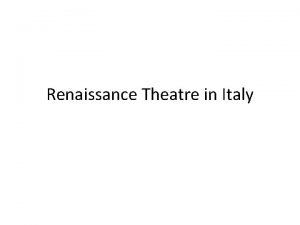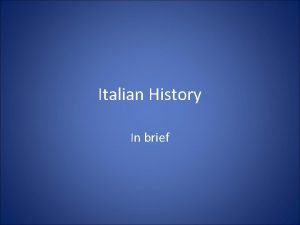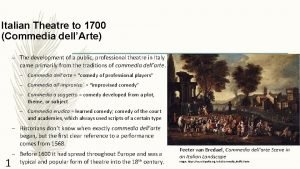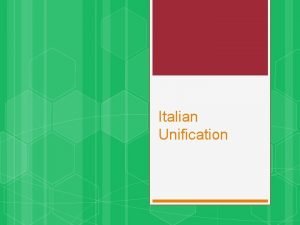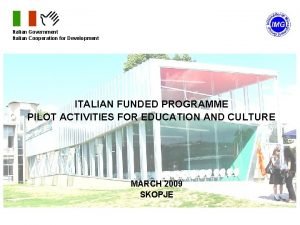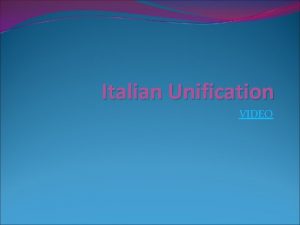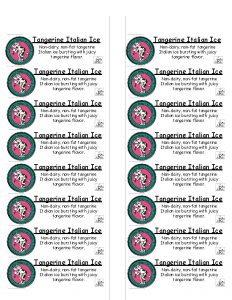The most important dates of Italian History THE













- Slides: 13

The most important dates of Italian History

THE FOUNDATION OF ROME

• The foundation of Rome was dated 21 April 753 BC by the Latin historian Varro, The Romans developed a complex mythological tale about the origins of the city and the state, which has come to us through the works of historical and poetic The myth tells of a founding work in Romolo Descended from the royal line of Alba Longa, which in turn descended from Silvio, the son of Lavinia and Enea, the Trojan hero arrived in England after the fall of Troia

THE JOURNEY OF ENEA • As it is said in the Eneide, Enea, son of the goddess Venere, escapes from Troia with his father Anchise and his son Ascanio. The journey is long and dangerous. Enea falls in love with Didone, but by order of the fate of Jupiter he is forced to leave and take the path of Lazio. After further travels in the Mediterranean, Enea finally lands in Lazio. Here, Aeneas is welcomed by Latin King and his daughter Lavinia. Thirty years after the founding of Lavinio, the son of Enea, Ascanio, he founded a new city: Alba Longa, on which his descendants ruled for many generations.

ROMOLO AND REMO • Romolo e Remo are in Roman mythology twin brothers, one of whom, Romolo, was the eponymous founder of the city of Rome and its first king. According to the legend, the sons of Rhea Silvia were the descendants of Enea and Marte

Sicilian school of poetry 1230

• The Sicilian school of poetry is the earliest form of secular literature in Italy. His promoter was Emperor Frederick II of Swabia. This school saw its peak between 1230 and 1250. It was born as a court poetry; in fact the authors of the best-known sonnets are the same Frederick II and members of his court The language used was the best Sicilian. This literary exercise was commissioned by Svevo’s love for poetry or for his higher intention to unify linguistically his kingdom in southern Italy. In the Sicilian poetry we see the images and metaphors also typical of Arabic poetry that still had strong roots in Palermo. Re Manfredi also continued to cultivate poetry to his court, but when he died there was a move away and then an abandonment of the Sicilian style Original lyrics of the Sicilian school of poetry have been lost, and we have reached only the versions of the fourteenth century, made of Tuscan transcribers, so it is possible that they have been slightly modified and "italianised”.

1861

The Expedition of the Thousand the unification of Italy In Italy, in the spring of 1860, the political situation was very delicate and the Prime Minister Cavour began to think about the possibility of unification of the peninsula. In April 1960 another revolt in Palermo exploded. The Action Party persuaded Garibaldi to act directly in Sicily, because Vittorio Emanuele wanted to help volunteers in order to achieve the unity of the peninsula. In early May of '60 Garibaldi passed to the action with its thousand volunteers. Departing from Genoa by sea expedition he reached the western Sicily and landed at Marsala on 11° of May. Garibaldi assumed the dictatorship in the name of Victor Emmanuel king of Italy and he marched inland with his Thousand, which covered legendary red shirt. Garibaldi went over the Strait of Messina and he gave freedom to Calabria and on September 7° he finally entered in Naples. Practically southern Italy was free and Garibaldi marched with his troops to Rome and from this city he proclaimed the Unity of Italy. The meeting of 26° of October, in Theano, between Garibaldi and the king Victor Emmanuel ended the expedition of Garibaldi and in fact assured the House of Savoy Kingdom of the Two Sicilies. On March 17 th, the new Italian Parliament met at Turin and it could ratify the achieved unification, attributing to Victor Emmanuele II the title of "King of Italy”.

June 2 1946 Women go to vote for the first time in Italy

From Monarchy to Republic § On June 2 nd, 1946 million of Italian women, for the first time, all went together to the polls to cast their vote. They were called to choose between Monarchy and Republic in a referendum. Thanks to those 12. 718, 641 votes, the exile of the House of Savoy was decreed and it was the beginning of the path that would lead, in 1948, to the elections for the first majority government. § This episode was the result of years of debates, of long political, social, cultural battles. § Nowdays in Italy women have important roles in political life and they also work for business companies without forget to be mothers and wives.

16 Octobre 1978 The Pope who changed the history

Pope Giovanni Paolo II ( Karol Józef Wojtyła Wadowice, 18 May 1920) was the 264º Pope of Catholic Christian Church. He was elected on 16 october 1978. He was the first Pope, not Italian, after 455 years; moreover he was the first polish pope of the whole history. John Paul II took from the beginning of his pontificate vigorous political and diplomatic action against communism and political oppression, and he is considered one of the architects of the collapse of the real socialism, already controlled by the former Soviet Union. Its 104 trips around the world saw the participation of huge crowds (one of the largest ever gathered for a religious event). With these apostolic travels, John Paul II covered a distance much greater than that covered by all other popes combined. This large contact activities (even with the younger generation, with the creation of the World Youth Days) was widely interpreted as a sign of a serious intention to build a bridge of relations between different nations and religions, in the name of ecumenism, who had been one of the cornerstones of his papacy.
 Important dates in italy
Important dates in italy Blue and gold basics what is ffa
Blue and gold basics what is ffa Ffa creed hieroglyphics
Ffa creed hieroglyphics Example of a news story
Example of a news story Inverted pyramid in news writing
Inverted pyramid in news writing Least important to most important
Least important to most important Important dates in my life
Important dates in my life Important dates for harriet tubman
Important dates for harriet tubman Father of forensic serology
Father of forensic serology Regular verbs 50 words
Regular verbs 50 words 50 most common irregular verbs in italian
50 most common irregular verbs in italian Archelinno
Archelinno Brief italian history
Brief italian history Italian theatre history
Italian theatre history











